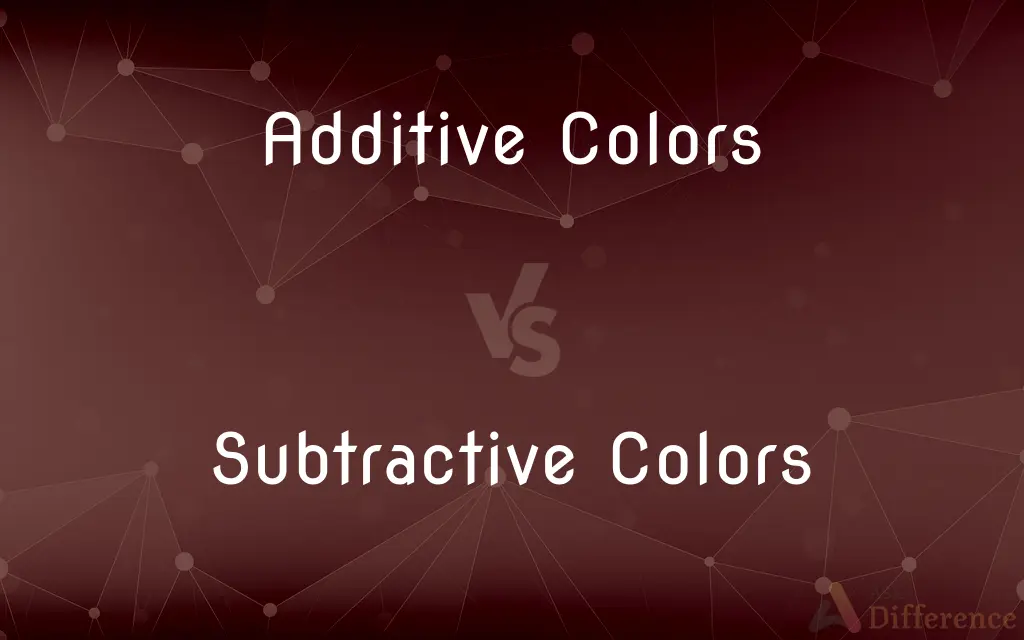Additive Colors vs. Subtractive Colors — What's the Difference?
By Tayyaba Rehman — Published on December 23, 2023
Additive Colors combine light sources to form white; Subtractive Colors mix pigments, absorbing light to produce black.

Difference Between Additive Colors and Subtractive Colors
Table of Contents
ADVERTISEMENT
Key Differences
Additive Colors are based on the principle of combining light sources. When light colors are added together, the resultant color becomes brighter. This is the logic behind screens and digital displays, where colors combine to produce varying hues. Subtractive Colors, conversely, operate on the principle of mixing pigments or dyes. When pigments are mixed, they absorb more light, and the resultant color becomes darker.
In the realm of Additive Colors, the primary colors are red, green, and blue (RGB). When these primary colors are combined, they produce white light. In contrast, in the world of Subtractive Colors, the primary colors are cyan, magenta, and yellow (CMY). Mixing these primary colors produces black or a darker shade, since they absorb more wavelengths of light.
Additive Colors find their primary applications in electronic displays, like televisions, computer monitors, and smartphone screens. These devices emit light, and by adjusting the intensity of red, green, and blue light, a wide range of colors can be produced. Subtractive Colors dominate in print media and artwork. When artists mix paints or when printers combine inks, they are using the principles of subtractive color mixing.
It's essential to understand the fundamental difference between Additive and Subtractive Colors, especially in design and media fields. Using Additive Colors is about manipulating light directly, emitting specific colors to produce the desired result. Meanwhile, using Subtractive Colors involves controlling how much light a surface absorbs and reflects, using pigments or dyes to achieve the desired color.
In essence, Additive Colors and Subtractive Colors represent two different ways colors interact, either through light emission or light absorption. Both play pivotal roles in various industries, from entertainment to art and design.
ADVERTISEMENT
Comparison Chart
Primary Colors
Red, Green, Blue (RGB)
Cyan, Magenta, Yellow (CMY)
Result of Mixing Primaries
White
Black or Darker Shades
Applications
Electronic displays (TVs, computer screens)
Print media, artwork (paints, inks)
Principle
Combining light sources
Mixing pigments or dyes
Interaction of Light
Light emission
Light absorption and reflection
Compare with Definitions
Additive Colors
Result in brighter colors when combined.
Combining all Additive Colors in full intensity produces white.
Subtractive Colors
Result in darker colors when combined.
Mixing all primary Subtractive Colors often leads to black.
Additive Colors
Colors produced by combining light sources.
Television screens use Additive Colors to create vibrant visuals.
Subtractive Colors
Dominant in print media and artworks.
Traditional art techniques revolve around Subtractive Colors.
Additive Colors
Based on red, green, and blue (RGB) primary colors.
LED lights often work on the principle of Additive Colors.
Subtractive Colors
Absorb and reflect light to form colors.
The pages of magazines showcase the brilliance of Subtractive Colors.
Additive Colors
Combine light intensities to achieve desired hues.
Adjusting the RGB values can change Additive Colors on a screen.
Subtractive Colors
Colors achieved by mixing pigments or dyes.
Painters use Subtractive Colors when blending their paints.
Additive Colors
Predominant in digital and electronic displays.
Smartphone screens emit Additive Colors for display.
Subtractive Colors
Operate on cyan, magenta, and yellow (CMY) primary colors.
Printers use Subtractive Colors to produce a range of hues.
Common Curiosities
How do Additive Colors appear brighter when combined?
By adding light intensities together, the resultant color becomes brighter.
What are Subtractive Colors?
Subtractive Colors arise from mixing pigments or dyes, primarily cyan, magenta, and yellow.
Why do Subtractive Colors darken when mixed?
Because they absorb more wavelengths of light, reducing the reflected light.
Where are Subtractive Colors commonly used?
In print media, artwork, and any application involving pigments or dyes.
Where are Additive Colors commonly used?
In electronic displays like TVs, computer monitors, and smartphones.
What are Additive Colors?
Additive Colors result from combining light sources, primarily red, green, and blue.
What happens when all Additive Colors are combined?
They produce white light.
What happens when all Subtractive Colors are mixed?
They result in black or a darker shade.
Can I use Additive Colors for print?
No, print primarily uses Subtractive Colors due to the nature of inks and pigments.
Why is understanding Additive and Subtractive Colors important in design?
Because the medium (digital or print) dictates the color system used to achieve the desired results.
Are the primary Additive Colors the same as the primary Subtractive Colors?
No, Additive Colors use red, green, and blue, while Subtractive Colors use cyan, magenta, and yellow.
Is RGB related to Additive or Subtractive Colors?
RGB is related to Additive Colors.
Can understanding Additive and Subtractive Colors improve photography?
Yes, knowing how light and pigments interact can help photographers achieve better color accuracy and results.
Is CMYK related to Subtractive Colors?
Yes, CMY(K) uses the Subtractive Colors principle, with 'K' representing black.
Why does mixing paints differ from mixing light?
Because paints operate on Subtractive Colors, absorbing light, while light mixing operates on Additive Colors, emitting light.
Share Your Discovery

Previous Comparison
Primary Evidence vs. Secondary Evidence
Next Comparison
Capital Reserve vs. Reserve CapitalAuthor Spotlight
Written by
Tayyaba RehmanTayyaba Rehman is a distinguished writer, currently serving as a primary contributor to askdifference.com. As a researcher in semantics and etymology, Tayyaba's passion for the complexity of languages and their distinctions has found a perfect home on the platform. Tayyaba delves into the intricacies of language, distinguishing between commonly confused words and phrases, thereby providing clarity for readers worldwide.
















































